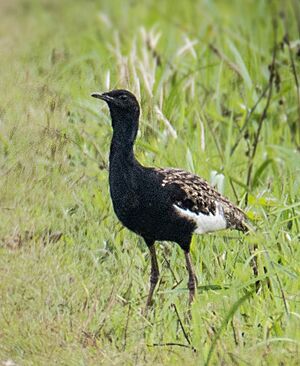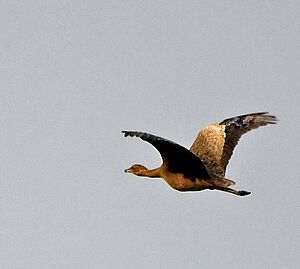Bengal florican facts for kids
Quick facts for kids Bengal florican |
|
|---|---|
 |
|
| A male Bengal florican | |
| Conservation status | |
| Scientific classification | |
| Genus: |
Houbaropsis
|
| Species: |
bengalensis
|
| Synonyms | |
|
Eupodotis bengalensis (Gmelin, 1789) |
|
The Bengal florican (scientific name: Houbaropsis bengalensis), also known as the Bengal bustard, is a special type of bird. It lives in parts of Asia, including the Indian subcontinent, Cambodia, and Vietnam. This bird is very rare. In fact, it's listed as Critically Endangered because experts believe there are fewer than 1,000 of these birds left. The Bengal florican is the only bird in its group, called Houbaropsis.
What Does It Look Like?
Male Bengal floricans are easy to spot. They have shiny black feathers on their head, neck, and belly. They also have a long, floppy crest on their head and special long feathers on their neck for showing off. Their back is a light brown color with black patterns. A big white patch on their wings stands out. When a male flies, its wings look almost completely white, except for the dark tips. Their legs and feet are yellow, and their eyes are dark.
Female Bengal floricans look different. They are mostly buff-brown, similar to the male's back. They have a dark brown top of the head and thin dark stripes on the sides of their neck. Their wing feathers are lighter than the main flight feathers and have fine dark stripes. Young Bengal floricans look similar to the females.
Adult Bengal floricans are about 66 to 68 centimeters (26-27 inches) long. They stand around 55 centimeters (22 inches) tall. Females are a bit bigger and heavier than males. Females weigh about 1.7 to 1.9 kilograms (3.7-4.2 pounds). Males weigh around 1.2 to 1.5 kilograms (2.6-3.3 pounds).
These birds are usually quiet. But if something scares them, they make a metallic "chik-chik-chik" sound. When male birds are trying to attract a mate, they make croaking sounds and a deep humming noise.
The only other bird that looks a bit like the male Bengal florican is the lesser florican. However, the lesser florican is smaller and has a thinner neck. Its males have special feather tufts on their cheeks instead of a crest.
Where Do They Live and What's Their Home Like?

Bengal floricans live in two main areas that are far apart. One group lives in northern India and southern Nepal. The other group lives in Cambodia and possibly southern Vietnam.
These birds usually stay in the same area where they breed. But in Cambodia, near a big lake called Tonlé Sap, they use grasslands near the lake for breeding. When the rainy season comes and the breeding grounds flood, they move away from the water. The birds in Nepal also seem to move to warmer, lower areas during winter. However, they don't travel very far, usually only a few dozen kilometers.
Bengal floricans prefer open areas with tall grasses and a few scattered bushes. Some of the important grasses they like are satintail, sugarcane, and munj grass. You can usually spot these birds in the early mornings and evenings. They are easiest to see during their breeding season, which is from March to August. This is when most counts of their population happen. Between March and May, males put on amazing displays to attract females. This makes them much easier to see than the females, who are camouflaged and prefer to hide in tall sugarcane fields.
Why Are They Endangered and How Are They Protected?
The Bengal florican is the rarest type of bustard bird in the world. It lives in small patches of grassland across South and Southeast Asia. These birds are in danger because their homes are being turned into farms, especially for growing rice. Poaching (illegal hunting) is also a big problem in Southeast Asia.
The number of Bengal floricans has dropped a lot in recent years. In South Asia, there are fewer than 350 adult birds left. About 85% of these live in India. While the birds in Southeast Asia are also very threatened, their numbers might be similar to or even less than those in South Asia. Because of this big drop in numbers, the Bengal florican was moved from "Endangered" to "Critically Endangered" on the IUCN Red List in 2007.
In Cambodia, many Bengal floricans are found in Kampong Thom Province. The Cambodian government is working to protect their habitat. They have set aside large areas where farming practices are changed to help the birds. They also have a program to teach schoolchildren about the Bengal florican.
In Nepal, these birds mostly live in protected areas like Shuklaphanta National Park, Bardia National Park, and Chitwan National Park. While some populations have been stable, others have declined.
Many naturalists have written about the amazing courtship display of the male Bengal florican. Today, this display attracts tourists, which helps local communities. Studies show that Bengal floricans are not very shy of people. They mainly avoid areas where their grassland homes are cleared for farming. They seem to be fine with traditional ways of using land, like villagers harvesting tall grass for building or crafts.
In fact, if people collect firewood and timber from grasslands instead of forests, it can actually help the Bengal florican. Some trees can take over the florican's grassland habitat. A good way to help these birds is to manage the land carefully. This means harvesting grass and wood from different areas each year, leaving some parts untouched, and setting aside other areas as reserves where grasses can grow tall for many years. Sometimes, controlled burning of old grass is needed to stop trees from growing too much. This should be done before March so that young birds are not harmed.
To truly save the Bengal florican and its grassland homes, we need to think about how people, nature, and the environment all work together.




